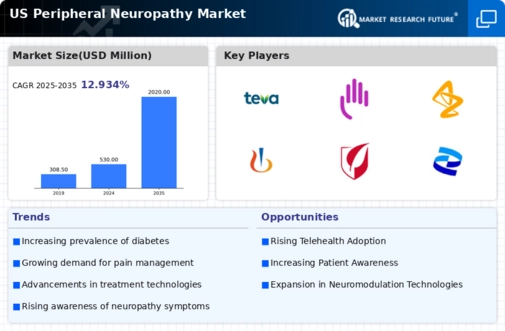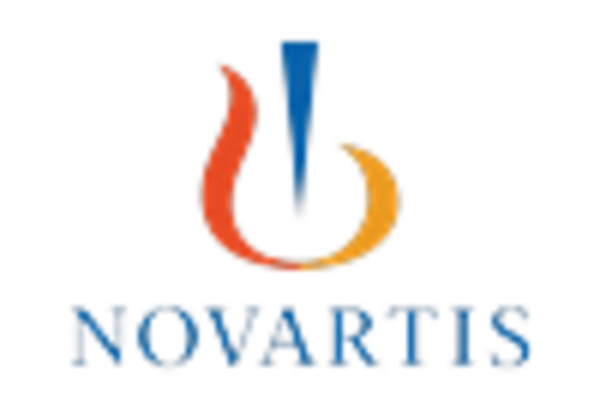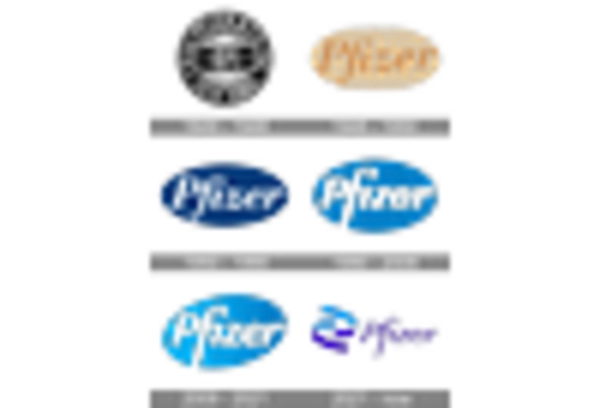Rising Healthcare Expenditure
The increase in healthcare expenditure in the US is another driver impacting the peripheral neuropathy market. With healthcare spending projected to reach approximately $6 trillion by 2027, there is a growing investment in research and development for new therapies and treatment options. This financial commitment is likely to enhance the availability of innovative drugs and therapies for managing peripheral neuropathy. Furthermore, as insurance coverage expands, more patients may gain access to necessary treatments, thereby boosting the overall market. The peripheral neuropathy market stands to gain from this trend as healthcare systems prioritize effective management of chronic conditions.
Technological Innovations in Diagnostics
Technological advancements in diagnostic tools are transforming the landscape of the peripheral neuropathy market. Innovations such as high-resolution imaging and electrophysiological testing have improved the accuracy of diagnosing neuropathic conditions. These advancements enable healthcare providers to identify peripheral neuropathy more effectively, leading to timely interventions. The market for diagnostic devices is projected to grow significantly. Estimates suggest a compound annual growth rate (CAGR) of around 8% over the next five years.. As diagnostic capabilities improve, the peripheral neuropathy market is likely to benefit from increased patient referrals and treatment initiation.
Aging Population and Associated Health Issues
The aging population in the US is a significant factor influencing the peripheral neuropathy market. As individuals age, they become more susceptible to various health issues, including diabetes and other conditions that can lead to neuropathy. It is estimated that approximately 30% of older adults experience some form of neuropathic pain. This demographic shift is likely to increase the prevalence of peripheral neuropathy, thereby driving demand for treatments and therapies. The healthcare system is adapting to this trend by focusing on developing targeted interventions for older patients, which may further stimulate growth in the peripheral neuropathy market.
Increasing Awareness of Peripheral Neuropathy
The growing awareness of peripheral neuropathy among healthcare professionals and patients is a crucial driver for the peripheral neuropathy market. Educational initiatives and campaigns have been implemented to inform the public about the symptoms and potential causes of this condition. As awareness increases, more individuals are likely to seek medical advice, leading to higher diagnosis rates. This trend is reflected in the rising number of patients diagnosed with neuropathic conditions, which has been reported to be around 20 million in the US. Consequently, the demand for effective treatment options and management strategies is expected to rise, thereby propelling the peripheral neuropathy market forward.
Emergence of Multidisciplinary Treatment Approaches
The emergence of multidisciplinary treatment approaches is reshaping the peripheral neuropathy market. Healthcare providers are increasingly recognizing the need for comprehensive care that addresses the multifaceted nature of neuropathic pain. This approach often involves collaboration among neurologists, pain specialists, physical therapists, and psychologists. By integrating various treatment modalities, including pharmacological and non-pharmacological interventions, patient outcomes may improve significantly. This trend is likely to drive demand for a wider range of therapeutic options, thereby expanding the peripheral neuropathy market as healthcare systems adapt to more holistic treatment paradigms.

















Leave a Comment